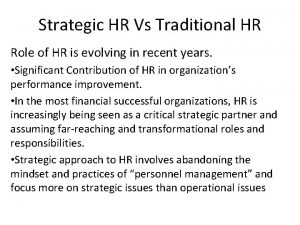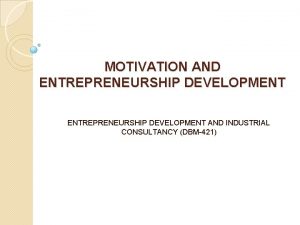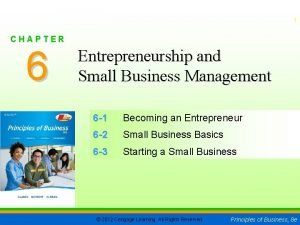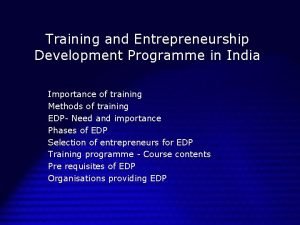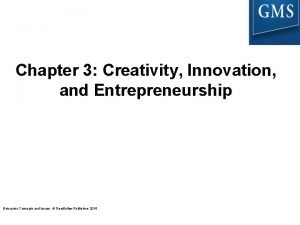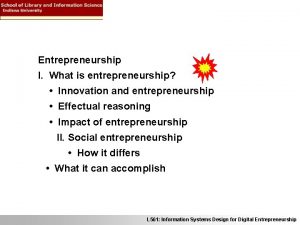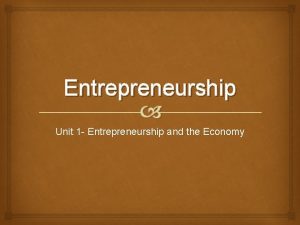Entrepreneurship and Employment Michael Fritsch 3 rd Summer










































- Slides: 42

Entrepreneurship and Employment Michael Fritsch 3 rd Summer School on “Knowledge Dynamics, Industry Evolution, and Economic Development”, Nice (France) July 11, 2014 Contact: Prof. Dr. Michael Fritsch, Friedrich Schiller University Jena, Carl-Zeiss-Str. 3, Room 5. 12 Phone (03641) 9 – 432 20, m. fritsch@uni-jena. de http: //www. wiwi. uni-jena. de/uiw/index. html Fritsch: Entrepreneurship and Economic Development, 3 rd KID Summer School, Nice, July 11, 2014 1

This lecture is based on Basic source: Fritsch, Michael (2013): New business formation and regional development - A Survey and Assessment of the Evidence. Foundations and Trends in Entrepreneurship, 9, 249– 364. Recent research papers: Fritsch, Michael and Florian Noseleit (2013): Investigating the Anatomy of the Employment Effect of New Business Formation. Cambridge Journal of Economics, 37, 349 -377. Fritsch, Michael and Florian Noseleit (2013): Start-Ups, Long- and Short-Term Survivors, and their Contribution to Employment Growth. Journal of Evolutionary Economics, 23, 719– 733. Fritsch, Michael and Florian Noseleit (2013): Indirect Employment Effects of New Business Formation Across Regions: The Role of Local Market Conditions. Papers in Regional Science, 92, 361 -382. Fritsch: Entrepreneurship and Economic Development, 3 rd KID Summer School, Nice, July 11, 2014 2

Main topics 1. Development of the research field 2. Theoretical and conceptual considerations 3. Results of empirical research 4. Implications for entrepreneurship policy 5. Avenues for further research Fritsch: Entrepreneurship and Economic Development, 3 rd KID Summer School, Nice, July 11, 2014 3

Joseph A. Schumpeter wanted to identify the sources of economic growth. He identified entrepreneurs who revolutionized the economy by introducing radical innovation. But these Schumpeterian entrepreneurs are very, very few! My question: What is the effect of new business formation in general on economic development? Fritsch: Entrepreneurship and Economic Development, 3 rd KID Summer School, Nice, July 11, 2014 4

The ‚Birch‘-debate Initiated by a study of David Birch: The Job Generation Process, Boston 1979: MIT (mimeo). Main statements of this study: Large firms in the USA have massively reduced employment during the 1970 s. In the same time period small firms in the USA have created many new jobs. A relatively large contribution to employment growth came from the service sector and from new businesses. The Birch-Study induced many empirical analyses of job generation by small and new firms and a long-lasting debate about the role of small businesses, particularly new businesses, in the economy. Fritsch: Entrepreneurship and Economic Development, 3 rd KID Summer School, Nice, July 11, 2014 5

New business formation and the market process Start-ups or market entries Supply-side effects: Securing efficiency Market process (selection) Acceleration of structural change Amplified innovation Greater variety New capacities: Development of new businesses Exiting capacities: Decline or closure of incumbents Improved competitiveness Growth Fritsch: Entrepreneurship and Economic Development, 3 rd KID Summer School, Nice, July 11, 2014 6

Direct and indirect effects of new businesses on growth New businesses Direct effect Growth Incumbent firms Indirect effect Hypothesis: The indirect effect of new business formation is much larger and more important than the direct effect (= development of the start-ups). Fritsch: Entrepreneurship and Economic Development, 3 rd KID Summer School, Nice, July 11, 2014 7

Direct and indirect effects of new business formation on economic development A positive effect of new business formation on employment can only result from the supply-side effects which occur rather indirectly. If competition does not work according to a survival of the fittest scenario then the supply-side effect of new business formation can well be negative. Not all start-ups will have the same effect on economic growth. It is particularly those start-ups that exert a strong challenge on incumbents (e. g. innovative start-ups) that have a main effect on growth. The indirect effect will be the larger, the more productive / innovative the reaction of the incumbents. The effects may be rather different across industries and regions. Fritsch: Entrepreneurship and Economic Development, 3 rd KID Summer School, Nice, July 11, 2014 8

Factors that may determine the effect of new business formation on regional development Fritsch: Entrepreneurship and Economic Development, 3 rd KID Summer School, Nice, July 11, 2014 9

Approaches to analyze the effect of new firm formation on economic development empirically Cohort analysis. Correlation and regression analysis (cross section, longitudinal) of the relationship between new firm formation rate and growth at an industry level at a regional level Including new firm formation / entrepreneurship into a regional production function. Dependent variable: employment, GDP, productivity (for smaller regions the available information on employment is most reliable). Fritsch: Entrepreneurship and Economic Development, 3 rd KID Summer School, Nice, July 11, 2014 10

Stylized paths in the numbers of entries, exits, and firms over the industry lifecycle Number of firms ‘Entrepreneurial‘ regime ‘Routinized‘ regime Shake out Number of entries Number of firms Number of exits Time Net entry Fritsch: Entrepreneurship and Economic Development, 3 rd KID Summer School, Nice, July 11, 2014 11

Analyzing the lag-structure of the effect of new businesses on employment – basic approach (Fritsch & Mueller, 2004) Regional employment change (%) t 0 = a + b 1 start-up rate t 0 + b 2 start-up rate t-1 + b 3 start-up rate t-2 + b 4 start-up rate t-3 + … + b 11 start-up rate t-10 + cn Xn + u Xn = further determinants, u = stochastic error term Method: Fixed-effects panel regression. Fritsch: Entrepreneurship and Economic Development, 3 rd KID Summer School, Nice, July 11, 2014 12

Effects of new firm formation on employment change over time – third-order polynomial New capacities III I Supply-side effects Exiting capacities II Source: Fritsch and Mueller (2004). Fritsch: Entrepreneurship and Economic Development, 3 rd KID Summer School, Nice, July 11, 2014 13

Evolution of employment in entry cohorts (all private industries) Source: Schindele and Weyh (2011). Fritsch: Entrepreneurship and Economic Development, 3 rd KID Summer School, Nice, July 11, 2014 14

Direct effect Regional data about employment cohorts of new businesses is used to analyze the direct effect. Largest impact on total employment change when the new businesses enter the market. Small positive contribution one year after start-up. Slightly negative impact in later periods. Fritsch: Entrepreneurship and Economic Development, 3 rd KID Summer School, Nice, July 11, 2014 15

Indirect effects Empirical strategy: Regress employment change of incumbents on start-up rate of the year t=0 and of each of the preceding ten years (t-1 to t-10) indirect effect Compute the average percentage employment change of the indirect effect “Reassemble” the overall effect Fritsch: Entrepreneurship and Economic Development, 3 rd KID Summer School, Nice, July 11, 2014 16

Fritsch & Noseleit (2013): The employment effect of shortterm and long-term survivors on regional growth Fritsch: Entrepreneurship and Economic Development, 3 rd KID Summer School, Nice, July 11, 2014 17

Results and conclusions Indirect effects are quantitatively much larger than direct effects. A large part of the “Birch-debate” was misleading. The effect may differ by type of start-up. Short-term survivors have no significant positive effect. The effect differs considerably by the size of the entry. Positive effects of new business formation on economic development occur with a considerable time-lag. Long-term policy orientation needed! Policy should not interfere with the process of market selection. No significant subsidization of new businesses after start-up! Presumably, the quality of start-ups with regard to challenging the incumbents is important for their effects. Try to increase the quality of start-ups and/or focus on higher quality start-ups! Fritsch: Entrepreneurship and Economic Development, 3 rd KID Summer School, Nice, July 11, 2014 18

What makes the “quality” of a start-up? Tautological definition: The higher the challenge for the incumbents the higher the quality of the start-up. The quality of a new business is indicated by: Ex ante indicators: Innovativeness of the supplied goods and services (e. g. , high tech manufacturing, knowledge intensive services, etc. ) ; Qualification of the entrepreneur (e. g. , academic start-ups); Main motivation for starting a business (e. g. , ‘opportunity’ versus ‘necessity’ entrepreneurship; part time versus full time entrepreneurship); Growth ambitions (e. g. , growth oriented versus non-growth oriented new businesses); Fritsch: Entrepreneurship and Economic Development, 3 rd KID Summer School, Nice, July 11, 2014 19

What makes the “quality” of a start-up? (continued) Ex ante indicators (continued): Amount and quality of the employed resources (e. g. size of start-up, team start-up, ability to attract VC, …); Productivity of start-up as compared to incumbents; … Ex post indicators: Survival over a certain period of time; Growth (e. g. ‘gazelles), size, market share after a certain time period ; … Fritsch: Entrepreneurship and Economic Development, 3 rd KID Summer School, Nice, July 11, 2014 20

The relationship between start-up rate and regional employment change Fritsch: Entrepreneurship and Economic Development, 3 rd KID Summer School, Nice, July 11, 2014 21

Effects of new firm formation on employment change in different types of region (West Germany) Source: Fritsch and Mueller (2008). Fritsch: Entrepreneurship and Economic Development, 3 rd KID Summer School, Nice, July 11, 2014 22

Impact of new firm formation on employment change – England vs. Scotland Wales Source: Mueller, van Stel and Storey (2008). Fritsch: Entrepreneurship and Economic Development, 3 rd KID Summer School, Nice, July 11, 2014 23

The effect of new business formation on regional employment in urban and rural in the Netherlands Source: Van Stel & Suddle (2008) Fritsch: Entrepreneurship and Economic Development, 3 rd KID Summer School, Nice, July 11, 2014 24

Regional differences I Direct effect Fritsch: Entrepreneurship and Economic Development, 3 rd KID Summer School, Nice, July 11, 2014 25

Regional differences II Indirect effects Fritsch: Entrepreneurship and Economic Development, 3 rd KID Summer School, Nice, July 11, 2014 26

Why Does the Effect of New Business Formation Differ Across Regions ? Estimation approach (Fritsch & Schroeter, 2011) Eit=0 / Eit-2 = a + b 1 * average start-up rateit + b 2 * average start-up rate 2 it + b 3 * control variableit + b 4 * control variableit * average start-up rateit + b 5 * control variableit + b 6 * control variableit * average start-up rateit + b 7 * average start-up rate in adjacent regionsit + u. Pure cross-section regressions using regional average values. Fritsch: Entrepreneurship and Economic Development, 3 rd KID Summer School, Nice, July 11, 2014 27

Marginal effect of start-ups on employment change Source: Fritsch & Schroeter (2011) Fritsch: Entrepreneurship and Economic Development, 3 rd KID Summer School, Nice, July 11, 2014 28

Marginal effect of start-ups on employment change with different levels of population density Source: Fritsch & Schroeter (2011) Fritsch: Entrepreneurship and Economic Development, 3 rd KID Summer School, Nice, July 11, 2014 29

The Role of Local Market Conditions for the Indirect Employment Effects (Fritsch & Noseleit, 2013) Results The indirect employment effect of new business formation is more pronounced in areas with relatively high population density than in less density regions. in small business regions than in large business regions. in regions characterized by a high concordance between the industry structures of start-ups and local incumbents than in regions where the correspondence of the industry structure of newcomers and incumbent firms is relatively low. in small business regions where there is also high similarity between the industry structure of start-ups and incumbents than in large business regions with high similarity. Fritsch: Entrepreneurship and Economic Development, 3 rd KID Summer School, Nice, July 11, 2014 30

Speculations: Why are the indirect effects so much higher in agglomerations ? Higher share of high quality start-ups in agglomerations because of higher qualification of the workforce? higher level of knowledge spillovers? higher level of cultural, technological and economic creativity? better supply of inputs? … Higher intensity of competition leading to higher quality of surviving start-ups and incumbents? − Could explain higher productivity and competitiveness of agglomerations. Competition on input or on output markets? Fritsch: Entrepreneurship and Economic Development, 3 rd KID Summer School, Nice, July 11, 2014 31

Policy Implications Safeguard that competition works according to a survival of the fittest. Do not interfere with this kind of selection. Focus on stimulating high quality start-ups. A main part of the measures for stimulating high-quality new businesses should be region-specific. A policy that aims at stimulating entrepreneurship needs a longterm perspective. … Fritsch: Entrepreneurship and Economic Development, 3 rd KID Summer School, Nice, July 11, 2014 32

Some avenues for further research Using other performance indicators than employment: GDP, productivity, innovation, … Analyzing direct employment effects / fast growing firms (gazelles) Identifying and analyzing the indirect effects of new business formation The effect of entries of different quality The role of new businesses for the generation and dissemination of innovation and knowledge (spin-offs) Universities and other research institutions as incubators (entrepreneurial university) The role of non-innovative entry Developing and analyzing indicators for the formation of growthrelevant new businesses Fritsch: Entrepreneurship and Economic Development, 3 rd KID Summer School, Nice, July 11, 2014 33

Some avenues for further research (continued) The role of the conditions on input and on output markets for the effects of new business formation on economic development Effects of entry on competition in input markets and output markets The role of the institutional environment The role of regional characteristics The role of the level of new business formation The role of the economic development level/ effects of new business formation on economic development in developing countries Entry as a cause or as a symptom of growth? Longer-run effects of new business formation on regional development Entrepreneurship policy (effectiveness, recommendations, etc. ) Fritsch: Entrepreneurship and Economic Development, 3 rd KID Summer School, Nice, July 11, 2014 34

Thank you for your attention ! Fritsch: Entrepreneurship and Economic Development, 3 rd KID Summer School, Nice, July 11, 2014 35

The effect of new business formation on regional employment in US-MSAs (Acs & Mueller, 2008) All start-ups Source: Acs & Mueller (2008) Fritsch: Entrepreneurship and Economic Development, 3 rd KID Summer School, Nice, July 11, 2014 36

The effect of new business formation on regional employment in US-MSAs (Acs & Mueller, 2008) Small start-ups Source: Acs & Mueller (2008) Fritsch: Entrepreneurship and Economic Development, 3 rd KID Summer School, Nice, July 11, 2014 37

The effect of new business formation on regional employment in US-MSAs (Acs & Mueller, 2008) Large start-ups Source: Acs & Mueller (2008) Fritsch: Entrepreneurship and Economic Development, 3 rd KID Summer School, Nice, July 11, 2014 38

Regression results for high and low population regions Fritsch: Entrepreneurship and Economic Development, 3 rd KID Summer School, Nice, July 11, 2014 39

Regression results for regions with high and low shares of small business employment Fritsch: Entrepreneurship and Economic Development, 3 rd KID Summer School, Nice, July 11, 2014 40

Regression results for high and low correspondence of industry structure between entries and incumbents Fritsch: Entrepreneurship and Economic Development, 3 rd KID Summer School, Nice, July 11, 2014 41

Regression results for small business regions Fritsch: Entrepreneurship and Economic Development, 3 rd KID Summer School, Nice, July 11, 2014 42
 Introduction to entrepreneurship module pdf
Introduction to entrepreneurship module pdf Short run phillips curve
Short run phillips curve Snap employment and training program texas
Snap employment and training program texas During the great depression union promoters
During the great depression union promoters Classical theory of income and employment
Classical theory of income and employment Traditional hr practices
Traditional hr practices Chapter 30 milady
Chapter 30 milady Nzrp quota
Nzrp quota Stuttering and employment discrimination
Stuttering and employment discrimination Anishinabek employment and training services
Anishinabek employment and training services Moodfx
Moodfx Gila river employment and training
Gila river employment and training Chapter 8 employment labor and wages
Chapter 8 employment labor and wages International and comparative employment relations
International and comparative employment relations Entrepreneurship and small business management
Entrepreneurship and small business management Difference between entrepreneurs and managers
Difference between entrepreneurs and managers Motivation and entrepreneurship development
Motivation and entrepreneurship development Characteristics of micro enterprise
Characteristics of micro enterprise Entrepreneurship and business management n5 textbook pdf
Entrepreneurship and business management n5 textbook pdf Chapter 6 entrepreneurship and starting a small business
Chapter 6 entrepreneurship and starting a small business Chapter 5 entrepreneurship and small business
Chapter 5 entrepreneurship and small business Entrepreneurship chapter 5
Entrepreneurship chapter 5 Entrepreneurship and small business management chapter 6
Entrepreneurship and small business management chapter 6 Types of innovation in entrepreneurship
Types of innovation in entrepreneurship Entrepreneurship chapter 6
Entrepreneurship chapter 6 Unit 5 entrepreneurship and business
Unit 5 entrepreneurship and business Nature and importance of entrepreneurship
Nature and importance of entrepreneurship Needs and wants in business
Needs and wants in business The social and ethical perspectives of entrepreneurship
The social and ethical perspectives of entrepreneurship Five roots of opportunity
Five roots of opportunity Chapter 5 entrepreneurship and small business
Chapter 5 entrepreneurship and small business Entrepreneurship and innovation bangalore university
Entrepreneurship and innovation bangalore university Chapter 6 entrepreneurship and starting a small business
Chapter 6 entrepreneurship and starting a small business Chapter 6 entrepreneurship and starting a small business
Chapter 6 entrepreneurship and starting a small business Entrepreneurship new ventures and business ownership
Entrepreneurship new ventures and business ownership Importance of edp
Importance of edp Global entrepreneurship and development index
Global entrepreneurship and development index Advantages and disadvantages of entrepreneurship
Advantages and disadvantages of entrepreneurship Institutions supporting entrepreneurs
Institutions supporting entrepreneurs Aims and objectives of entrepreneurship
Aims and objectives of entrepreneurship Example of creativity and innovation in entrepreneurship
Example of creativity and innovation in entrepreneurship Entrepreneurship chapter 6
Entrepreneurship chapter 6 Strategy innovation and entrepreneurship
Strategy innovation and entrepreneurship





